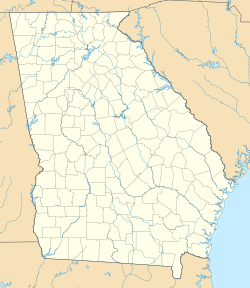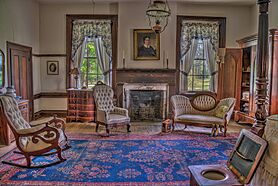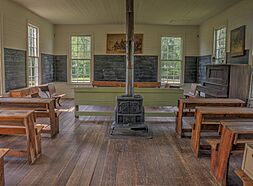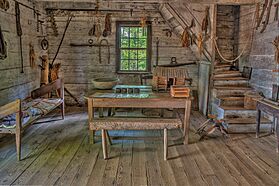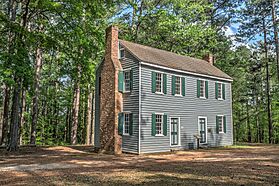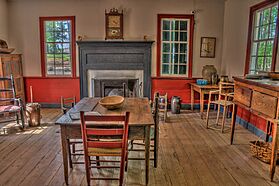Callaway Plantation facts for kids
Quick facts for kids |
|
|
Arnold-Callaway Plantation
|
|
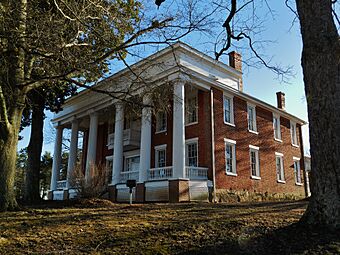 |
|
| Location | NW of Washington on U.S. 78, Georgia, U.S. |
|---|---|
| Architectural style | Greek Revival |
| NRHP reference No. | 72000402 |
| Added to NRHP | April 11, 1972 |
The Callaway Plantation, also known as the Arnold-Callaway Plantation, is a group of old buildings and an open-air museum in Washington, Georgia. This place used to be a large cotton farm, called a plantation. Many African American people were forced to work there as slaves.
The Callaway family owned this land from 1785 until 1977. They still own a lot of land around the museum today. When the plantation was active, it was very big and had hundreds of enslaved people working on it.
The museum covers about 56-acre (230,000 m2) of land. It includes the main houses that the family gave to the city of Washington in 1977. Other buildings were moved to the site to show what a typical plantation looked like. The city of Washington, Georgia, runs the museum. This site is important because its main house is a rare example of Greek Revival architecture used for a plantation. It also shows a style called classicism from the time after the American Civil War. The plantation has been on the National Register of Historic Places list since April 11, 1972.
Contents
Callaway Family History
The Callaway family in Georgia came from Peter Callaway (1640–1715). He was an immigrant who moved to the United States from England. Other famous Callaway family members, like Fuller Earle Callaway and Cason Jewell Callaway, were from a different part of the family. Their family moved to western Georgia, to cities like Columbus and LaGrange.
Early Years (1700s)
In 1783, Thomas Edward Callaway and his family moved to Georgia from Halifax County, Virginia. They had also lived in North Carolina. In 1785, John Callaway (1746–1821), one of Thomas Edward Callaway's four sons, received 200 acres of land from the state of Georgia. This land was about 9 miles west of Washington, Georgia.
John Callaway built a one-room log cabin on his new property. This cabin is no longer standing, but it was near the Callaway family cemetery. John Callaway and his son Enoch Callaway owned many enslaved African Americans. The plantation grew cotton, which was sold to other countries. The enslaved people lived in log cabins close to the main house.
Growth and Change (1800s)
When John Callaway died in 1821, he left 25 enslaved African Americans to his children in his will. He was buried in the Callaway family cemetery. This cemetery was already there before John was buried, with graves of former neighbors marked by simple stones. John's son Enoch Callaway died in 1859. He left 8 enslaved African Americans in his will. When enslaved people died, they were buried in a separate burial ground just for African Americans. This burial ground was no longer used after 1910 and is not there anymore.
Jobe Callaway got married and moved to Chambers County, Alabama. But he later came back to Callaway Plantation. When Jobe Callaway died at the plantation, he left 558 acres of land to his son Jacob. Jacob Callaway (1760–1855) built his home in 1817. He became very wealthy before the American Civil War. He grew a lot of cotton and sold it to England.
By 1855, Jacob Callaway's son Parker inherited 100 acres near "Fishing Creek." He started buying more land from his relatives. By the time he died, he owned over 3060 acres. Jacob Callaway had money from his last cotton shipment in the Bank of England. He could not get this money until after the Civil War ended in 1865, which was after Jacob had died. The Callaway family made a lot of money from the interest on this money. They used it to build the large brick manor house by 1869, led by Jacob's grandson, Aristides.
Modern Era (1900s)
Parker Callaway's son, Aristides, sold most of the 3060+ acre property to W. R. Callaway, Enoch Jones, and Lucy A. Jones. When Aristides Callaway died, he left over 400 acres to two of his children. Aristides' granddaughter, Katie Mae Arnold Hardin (1888–1977), gave her part of the Callaway property to the city of Washington, Georgia. This land became the museum site.
Plantation Architecture
There are many buildings on the Callaway Plantation property. The most important ones include the Parker Callaway homestead, built around 1817. Another key building is Aristides Callaway's Greek Revival brick manor house, built around 1869. People sometimes call it "the brickhouse."
Other buildings on the site include Jacob Callaway's Grey House, built in 1790. There is also a log cabin from around 1785, and a one-room schoolhouse built in 1891. The Dally Slave Cabin, built in 1840, and a general store from 1930 were also moved to the site from other places in Georgia to create the museum. You can also see a corn crib, a house for making bricks, and a smoke house.
The main manor house, built by Aristides Callaway, was very large and impressive. It was built after the American Civil War, during the "Reconstruction-era." Its size showed that the family was very wealthy. Bricks were not a common building material in that area or at that time.
The Grey House was built in 1790 by Jacob Callaway and is still on the property. It is a two-story house built in the Federal Plain style. Inside the Grey House, you can see furniture and decorations from that time period.
Visiting the Museum
The Callaway Plantation museum is located across from the Washington-Wilkes airport. However, when you look at pictures, it still looks like a quiet, rural plantation. There is a small fee to enter the museum. You can buy souvenirs and get information at the general store. The buildings display old furniture, tools, and other items that show what life was like long ago.
- Callaway Plantation buildings
See also


